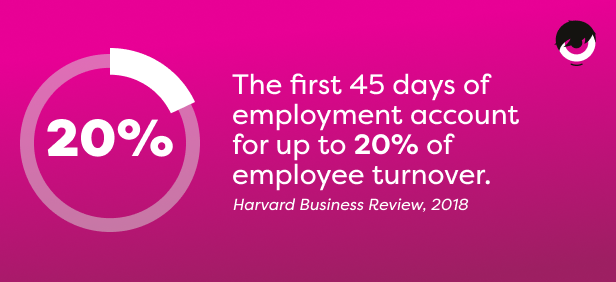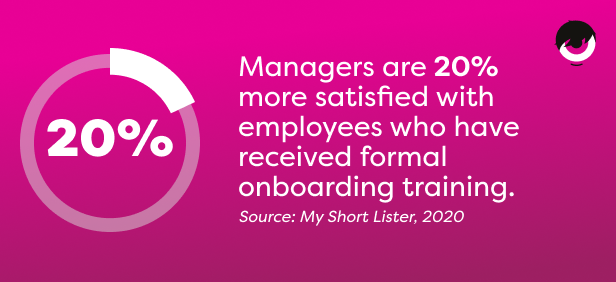We all know that employee onboarding programs are a crucial part of your HR strategy… right? Sometimes, you need numbers to realize how essential strong onboarding processes and good employee experience are for your company culture.
In this article, you’ll find vital onboarding statistics you need to know to build a proper onboarding strategy and helpful tips on gathering onboarding data in your company!
Onboarding Costs Statistics
Speaking of numbers and statistics: have you ever wondered how much onboarding costs your organization? Here is helpful information to get a good idea of your onboarding budget:
1. The average cost of hiring a new employee is around $4000. (Glassdoor, 2019)
The average cost of hiring a new employee is around $4000 depending on the role and the size and location of your company. Cost-per-hire includes the external and internal recruiting costs and the time spent researching and screening candidates.
To avoid repeating this expensive process, you need to reduce the risks of new hire turnover by offering your new employee the onboarding program they deserve – and expect from you.
2. Replacing an employee costs around 20% of the employee’s pay. (CentricHR, 2022)
These numbers apply to mid-range positions, as managers and executives are much more expensive to replace.
On top of salary, you need to allocate expansions to recruiting, training, and time-consuming HR tasks that are an integral part of employee onboarding processes.
3. A bad hire costs up to 30% of the employee’s first-year earnings. (ApolloTechnical, 2023)
These costs are estimated by taking into account compensation and training costs and the loss of productivity caused by a bad hire. Optimizing recruitment processes is essential to avoid these situations, but you also need to provide proper training and orientation during your onboarding program to prevent misunderstandings and inefficiency.
Onboarding and Employee Turnover Statistics
Did you know that the quality of a new recruit’s onboarding has a major impact on their future retention? Here’s why:
4. The first 45 days of employment account for up to 20% of employee turnover. (HarvardBusinessReview, 2018)
These statistics prove that effective onboarding processes is strongly related to retention, and that your company will benefit from improving its practices in that regard. Considering the costs of employee turnover and the impact unmotivated employees have on your productivity, you need to put onboarding at the center of your HR strategies in 2024.

5. 88% of companies could improve their onboarding program. (Gallup, 2017)
According to Gallup, these companies admit that their onboarding processes are not optimal, leading to higher turnover rates, losses of motivation, and an unconvincing employer brand. Remember: employees and candidates share their experience with companies, and if they have a bad first impression, you will stop attracting skilled workers in your organization.
6. 28% of recruits leave their jobs after three months. (HRDive, 2017)
A good onboarding program stretches over several months, and it is crucial to provide a good onboarding experience throughout this period of time. Employees who leave during the first three months in their new position do so because they were disappointed in their onboarding journey. Make sure that you give them reason enough to stay by your side in the long run!
7. Good onboarding processes can increase retention levels by 82%. (BrandonHallGroup)
These numbers prove the strong link between onboarding experience and high turnover rates, and that your onboarding program needs to be the first step in your retention strategy. Think about all the resources and time you spent on hiring, and how they could be wasted if you fail to convince your new employee that they have made the right choice by joining your organization!
8. New employees take about 8 to 12 months to become as efficient as their coworkers. (ClickBoarding, 2020)
These statistics show that you need to provide comprehensive training throughout the entire onboarding journey. Extensive training will help new hires reach their full potential more quickly, and they will be more likely to stay in your company.
Onboarding Challenges
Organizations face a variety of challenges related to onboarding processes, such as issues in paperwork management, access to company tools and individual struggles experienced by new employees. Here are key statistics you should know:
9. Remote onboarding is a major challenge for 37% of HR pros. (Workable)
Proper integration and understanding of the company culture and structure can be difficult for remote workers. Of course, managing remote workers requires extensive and effective communication, but performance issues and misunderstandings can be noticed more quickly in-person. Organizing remote team-building activities that foster team spirit can also be challenging.
10. One of the top onboarding challenges is the disconnect between hiring and onboarding. (LeenaAI)
Many candidates feel pampered throughout the recruitment process, leading to high expectations which are then crushed by tedious, impersonal onboarding programs. New hires feel like they have been misled and that now that they are “secured” within the company, they will no longer be treated with the care and attention they need.
11. Only 40% of employees feel like their current position matches their expectations before being hired. (HiBob)
Once again, this mismatch between stimulating expectations and disappointing reality leads to a lack of motivation and productivity from new hires. Their initial excitement dies down, and they either become a disengaged worker or an employee already planning their departure.
12. 66% of employees struggle with job responsibilities and performance expectations during the onboarding period. (Talmundo)
These numbers can be explained by lack of training or ineffective communication of performance goals and how they align with business goals. Comprehensive performance management should be set up from the get go to make sure that the new hire is aware of their responsibilities and objectives, and receives all the support they need to fulfill them.
13. 56% of new employees struggle to access the technology tools they need to work. (Talmundo)
Although technology is essential to eliminate manual and repetitive processes and reduce risks of errors, your teams should be properly trained on how to use them effectively. A new hire should also be given all the necessary accesses on their very first day in their new position so that they can get familiar with the platforms they will have to use on a daily basis.
14. 42% of new employees think that information is too scattered in their organization. (Glean)
Your new employees should not struggle to retrieve information or to access the data they need to work and complete paperwork. Information scattered across various platforms leads to wasted time, misunderstandings and manual errors. It can also be discouraging for new hires to see that processes are not optimized in your organization.
15. Manual collection of onboarding paperwork leads to heavier workloads 37% of the time. (CareerBuilder)
Digitizing and centralizing your paperwork and document management is essential to provide a seamless onboarding experience. This also helps you avoid losses of information and time spent exchanging emails to obtain written signatures and scanned documents.
Employee Onboarding and Company Culture
Have you ever wondered what poor – or outstanding – onboarding practices say about your company culture? Here are key numbers you need to consider:
16. 25% of employers build only one-or-two-day long onboarding programs. (CareerBuilder)
Picture the following: you were a candidate convinced to join an organization that seemed to offer everything you could wish for. Your first day comes, and you see that nothing has been done to properly welcome you. No detailed program was built to support you throughout your onboarding journey. In fact, after barely two days, you are left to your own devices with no clue as to how you are going to succeed in your new position… Not a great look if you want to build an attractive company culture, right?
17. 8% of employees start their new jobs with no onboarding process. (Gallup)
Fortunately, the percentage is low, but still alarming: a lack of structured onboarding sets your new employee up for failure, as you can’t expect them to provide satisfactory work without giving them the necessary tools and support to do so.
18. Only 49% of employers provide a company overview during onboarding (CareerBuilder)
You should not only present the company structure and organizational chart during the onboarding journey, but also introduce the corporate culture to the newcomer so that they can already relate to your values and mission. Company culture is not accident – it should trickle down from the top to thrive at the bottom!
19. 38% of new hires don’t know to who they should address their questions. (Glean)
Employees who feel unsupported and lost will either lose time looking for information they could get from their manager or coworker, or give up on completing a specific task or project. Designating an onboarding mentor can be a great way to avoid such situations. Don’t forget to send onboarding emails sharing useful contact information your new hire should use when they encounter an issue.
20. 78% of hires said their good onboarding experience gave them a positive outlook toward their employer. (Talmundo)
These numbers make sense: first impressions are crucial when forming an opinion. If you want your new employees to have a positive attitude toward your company culture, start by showing them you care from their very first weeks.
21. 4 out of 5 employees say that onboarding programs help them understand company culture. (Talmundo)
Although company culture should be shared and promoted throughout the entire employee experience, the onboarding period is especially important to evaluate whether a new hire is a culture fit and will integrate seamlessly into the organization.
22. 45% of new hires who had a positive onboarding experience have more trust in their organization. (CareerBuilder)
On top of encouraging positive outlooks and attitudes, a memorable onboarding journey builds trust, which is essential to long-term productivity and employee happiness. If an employee has a relationship of trust with you, you can definitely trust that they will be doing a good job in return!
23. 31% of Gen Z and millenial job-seekers look for positions that provide opportunities of training and development. (LinkedIn)
Providing training opportunities from the onboarding stage shows new hires that they can grow and learn with you. Onboarding programs that leave time for comprehensive training increase the attractiveness of your employer brand and organizational culture, making future recruitment efforts much easier for your company.
Successful Onboarding Statistics
Now that we have seen how a poor onboarding experience can have a direct impact on employee retention and company productivity, we must highlight the benefits of successful onboarding. Here are some key components:
24. Employees integrated with effective onboarding programs are 69% more likely to stay for three years in your company. (MyShortLister, 2020)
Comprehensive onboarding programs support retention and engagement because they are the pillar of a healthy relationship between employers and employees. Remember that first impressions will define the image new hires have of your company.
25. 78% of employees would stay with their company if they saw a career path during their onboarding. (Mercer, 2018)
Possible career paths and professional growth opportunities must be discussed from the very first step of hire onboarding to help new employees plan their future within the organization. Therefore, you need to put training and development efforts at the forefront of your onboarding strategy to retain these 78% of workers who are eager to learn and grow by your side.
26. Managers are 20% more satisfied with employees who have received formal onboarding training. (MyShortLister, 2020)
This means that on top of increasing chances of long-term retention, effective onboarding training also improves productivity and your overall workflow. Invest in training opportunities from the get-go to make sure that your employee reaches their full potential.

27. Employees benefiting from extended onboarding programs reach their first milestone 34 times faster than other employees. (SHRM, 2017)
If we said it once, we said it a hundred times: your employee onboarding programs need to span across several months, or even a whole year, in order to be effective and supportive of learning and development. You are better off taking your time once to gain the best employee than rush through the process and having to repeat it dozens of times!
The Future of Employee Onboarding
Now that you know the current state of onboarding processes in most organization, you might wonder what steps you need to take to stay on top of essential trends in the future. What practices should you implement and what strategies should you prioritize to optimize hire retention and productivity? Let’s see what the numbers have to say!
28. Automating onboarding tasks results in a 16% increase in hire retention. (HiringThing, 2024)
Manual processes and piles of administrative papers are not the most encouraging thing to encounter when you take on a new position at a new company. Automating processes save both you and your hire precious time and energy to focus on what matters most.
Folks HR’s onboarding features let you build efficient onboarding programs and assign and schedule tasks directly on your platform, while sending automated reminders to avoid delays! Furthermore, e-signature features help you simplify and centralize employee document management.
29. 50% of HR pros believe that AI can improve onboarding processes. (LeenaAI, 2024)
Of course, AI tools will be at the center of conversations and take an active part in the reshaping of onboarding processes as we know them. Artificial intelligence will play a crucial role in automating, optimizing and customizing the entire employee experience according to a worker’s specific needs and preferences.
30. 77% of HR professionals think that onboarding processes will become increasingly important in the coming years. (Talmundo, 2024)
These numbers are telling: you need to invest resources and energy in optimizing onboarding processes sooner rather than later if you want to stay efficient in the future. Remember that HR tools can help you build effective strategies and that human support and extensive training are essential to offer a positive onboarding experience to your new employees.
Resources for Your Onboarding Strategy
The hiring process is expensive, partly because negative onboarding experiences can get quite costly. Moreover, there is a strong correlation between poor onboarding process and high voluntary turnover rates.
Disappointing recruits during their first days in the company means multiplying hiring and onboarding costs at a high rate. Who would want to start hiring and onboarding for the same position over and over again?
There is no doubt that a positive onboarding experience must be at the core of your employee engagement strategy. Fortunately, our blog is full of great tips to improve your employee onboarding practices and overcome onboarding challenges!
- Learn about the 4 steps of a structured onboarding process ;
- Build well-designed onboarding plans ;
- Discover original onboarding activity ideas ;
- Use our free onboarding email templates ;
- Improve your remote employee onboarding process;
- Follow our ultimate guide to employee onboarding .
Create a structured onboarding program with employee onboarding software!
Automate onboarding tasks and collect onboarding data on your all-in-one HR platform:

